Deck 12: Introduction to Ventilators
Question
Question
Question
Question
Question
Question
Question
Question
Question
Question
Question
Question
Question
Question
Question
Question
Question
Question
Question
Question
Question
Question
Question
Question
Question
Question
Question
Question
Question
Question
Question
Question
Question
Question
Question
Question
Question
Question
Question
Question
Question
Question
Question
Question
Question
Question
Question
Question
Question
Question
Question
Question
Question
Question
Question
Question
Question
Question
Question
Question
Question
Question
Question
Question
Question
Question
Question
Question
Question
Question
Question
Question
Question
Question
Question
Question
Question
Question
Question
Question

Unlock Deck
Sign up to unlock the cards in this deck!
Unlock Deck
Unlock Deck
1/107
Play
Full screen (f)
Deck 12: Introduction to Ventilators
1
An open-loop ventilator system can be described as which of the following?
A) Feedback
B) Hierarchical
C) Unintelligent
D) Servo-controlled
A) Feedback
B) Hierarchical
C) Unintelligent
D) Servo-controlled
C
Unintelligent ventilators are called open-loop systems because they do not respond to changes in the delivery of gas to the patient when there are any problems.
Unintelligent ventilators are called open-loop systems because they do not respond to changes in the delivery of gas to the patient when there are any problems.
2
A closed-loop ventilator system can be described as which of the following?
1)Feedback
2)Hierarchical
3)Unintelligent
4)Servo-controlled
A) 1
B) 2 and 3
C) 1 and 4
D) 2 and 4
1)Feedback
2)Hierarchical
3)Unintelligent
4)Servo-controlled
A) 1
B) 2 and 3
C) 1 and 4
D) 2 and 4
C
A closed-loop ventilator system is an intelligent system that can respond to certain inputs based on programming.This type of system is similar to cruise control on a car.When a parameter is set on the ventilator,the ventilator compares the input with the output and makes certain adjustments.These systems are also called feedback or servo-controlled systems.
A closed-loop ventilator system is an intelligent system that can respond to certain inputs based on programming.This type of system is similar to cruise control on a car.When a parameter is set on the ventilator,the ventilator compares the input with the output and makes certain adjustments.These systems are also called feedback or servo-controlled systems.
3
The main parameter that the ventilator manipulates for any given breath is referred to as which of the following?
A) Control circuit
B) Phase variable
C) Control variable
D) Cycle variable
A) Control circuit
B) Phase variable
C) Control variable
D) Cycle variable
C
The main parameter or variable controlled by the ventilator for any given breath is referred to as the control variable.A control circuit is part of the internal circuit of a mechanical ventilator and consists of mechanical devices,such as spring-loaded valves,pneumatic systems,or fluidic components.Phase variables are the variables that control the four phases of a breath.A cycle variable is the variable that is being used by the ventilator to end inspiration.
The main parameter or variable controlled by the ventilator for any given breath is referred to as the control variable.A control circuit is part of the internal circuit of a mechanical ventilator and consists of mechanical devices,such as spring-loaded valves,pneumatic systems,or fluidic components.Phase variables are the variables that control the four phases of a breath.A cycle variable is the variable that is being used by the ventilator to end inspiration.
4
The Downs continuous positive airway pressure system uses which of the following to establish positive airway pressure?
A) Weighted ball
B) Magnetic valve
C) Spring-loaded valve
D) Opposing gas flow
A) Weighted ball
B) Magnetic valve
C) Spring-loaded valve
D) Opposing gas flow

Unlock Deck
Unlock for access to all 107 flashcards in this deck.
Unlock Deck
k this deck
5
Which of the following variables ends the inspiratory phase?
A) Cycle
B) Limit
C) Trigger
D) Sensitivity
A) Cycle
B) Limit
C) Trigger
D) Sensitivity

Unlock Deck
Unlock for access to all 107 flashcards in this deck.
Unlock Deck
k this deck
6
Which of the following is a device that uses a flow resistor to create expiratory pressure?
A) Positive expiratory pressure mask
B) Downs continuous positive airway pressure generator
C) Modern ventilator
D) Fluidic device
A) Positive expiratory pressure mask
B) Downs continuous positive airway pressure generator
C) Modern ventilator
D) Fluidic device

Unlock Deck
Unlock for access to all 107 flashcards in this deck.
Unlock Deck
k this deck
7
A separation bubble in a fluidic device does which of the following?
A) Causes a flip-flop to occur
B) Causes a high-pressure vortex
C) Bends the gas jet stream toward the wall
D) Pushes the gas jet stream away from the wall
A) Causes a flip-flop to occur
B) Causes a high-pressure vortex
C) Bends the gas jet stream toward the wall
D) Pushes the gas jet stream away from the wall

Unlock Deck
Unlock for access to all 107 flashcards in this deck.
Unlock Deck
k this deck
8
The set tidal volume is 500 mL.During the first breath,the exhaled volume measures 390 mL,with a peak pressure of 18 cm H₂O.The second breath returns 460 mL,with 20 cm H₂O.The third breath has a peak pressure of 22 cm H₂O,with an exhaled volume of 500 mL.This can be described as what type of system?
A) Open-loop
B) Closed-loop
C) Single-circuit
D) Double-circuit
A) Open-loop
B) Closed-loop
C) Single-circuit
D) Double-circuit

Unlock Deck
Unlock for access to all 107 flashcards in this deck.
Unlock Deck
k this deck
9
Which of the following flow-controlling valves operates by using the principles of electromagnetism?
A) Poppet
B) Stepper motor
C) Proportional solenoid
D) Microprocessor-operated
A) Poppet
B) Stepper motor
C) Proportional solenoid
D) Microprocessor-operated

Unlock Deck
Unlock for access to all 107 flashcards in this deck.
Unlock Deck
k this deck
10
The gas that enters the ventilator from high-pressure sources goes directly to the patient.This is a description of a _____ system.
A) single-circuit
B) double-circuit
C) pneumatic circuit
D) power transmission
A) single-circuit
B) double-circuit
C) pneumatic circuit
D) power transmission

Unlock Deck
Unlock for access to all 107 flashcards in this deck.
Unlock Deck
k this deck
11
An iron lung is which type of ventilator?
A) Fluidic
B) Positive-pressure
C) Negative-pressure
D) Positive/negative pressure
A) Fluidic
B) Positive-pressure
C) Negative-pressure
D) Positive/negative pressure

Unlock Deck
Unlock for access to all 107 flashcards in this deck.
Unlock Deck
k this deck
12
A patient is receiving a continuous positive airway pressure of 10 cm H₂O via mask from a Downs continuous positive airway pressure generator.During each inspiration,the pressure manometer decreases to 3 cm H₂O.The patient is diaphoretic,tachypneic,and tachycardic. To correct this situation,the respiratory therapist should do which of the following?
A) Increase the gas flow
B) Increase the pressure
C) Tighten the fit of the mask
D) Replace the spring-loaded valve
A) Increase the gas flow
B) Increase the pressure
C) Tighten the fit of the mask
D) Replace the spring-loaded valve

Unlock Deck
Unlock for access to all 107 flashcards in this deck.
Unlock Deck
k this deck
13
A patient is receiving continuous positive airway pressure from a freestanding,continuous-flow system.The respiratory therapist notices the pressure-release valve venting on each patient exhalation.What action should the respiratory therapist take?
A) Replace the continuous positive airway pressure device
B) Decrease the flow rate
C) Increase the pressure level
D) Remove the pressure-release valve
A) Replace the continuous positive airway pressure device
B) Decrease the flow rate
C) Increase the pressure level
D) Remove the pressure-release valve

Unlock Deck
Unlock for access to all 107 flashcards in this deck.
Unlock Deck
k this deck
14
What variable begins the inspiratory phase of a ventilator?
A) Cycle
B) Limit
C) Control
D) Trigger
A) Cycle
B) Limit
C) Control
D) Trigger

Unlock Deck
Unlock for access to all 107 flashcards in this deck.
Unlock Deck
k this deck
15
The function of the exhalation valve in the external circuit is to do which of the following?
A) Deflate during inspiration to allow the gas to go to the patient
B) Inflate during inspiration to prevent leaks in the inspiratory circuit
C) Inflate during inspiration to divert gas coming from the ventilator into the patient
D) Inflate during expiration to allow the patient to exhale through the expiratory line
A) Deflate during inspiration to allow the gas to go to the patient
B) Inflate during inspiration to prevent leaks in the inspiratory circuit
C) Inflate during inspiration to divert gas coming from the ventilator into the patient
D) Inflate during expiration to allow the patient to exhale through the expiratory line

Unlock Deck
Unlock for access to all 107 flashcards in this deck.
Unlock Deck
k this deck
16
Which two of the following basic physical principles are used in the power transmission design of fluidic ventilators?
1)Venturi
2)Bernoulli
3)Beam deflection
4)Wall attachment
A) 1 and 2
B) 2 and 3
C) 3 and 4
D) 1 and 4
1)Venturi
2)Bernoulli
3)Beam deflection
4)Wall attachment
A) 1 and 2
B) 2 and 3
C) 3 and 4
D) 1 and 4

Unlock Deck
Unlock for access to all 107 flashcards in this deck.
Unlock Deck
k this deck
17
Which of the following is the flow waveform created by a linear-drive piston?
A) Sinusoidal
B) Rectangular
C) Ascending ramp
D) Descending ramp
A) Sinusoidal
B) Rectangular
C) Ascending ramp
D) Descending ramp

Unlock Deck
Unlock for access to all 107 flashcards in this deck.
Unlock Deck
k this deck
18
Which type of ventilator creates a sinusoidal pressure waveform pattern of positive and negative pressures?
A) Fluidic
B) Pneumatic
C) Positive-pressure
D) Combined-pressure
A) Fluidic
B) Pneumatic
C) Positive-pressure
D) Combined-pressure

Unlock Deck
Unlock for access to all 107 flashcards in this deck.
Unlock Deck
k this deck
19
A patient receiving continuous positive airway pressure of 7.5 cm H₂O via a mask and freestanding system appears to be in distress.The patient is using accessory muscles and is diaphoretic. The manometer is fluctuating between -5 cm H₂O on inspiration and 7.5 cm H₂O on expiration.The most apparent cause of the patient's distress is which of the following?
A) Leak in the system
B) Improper mask fitting
C) Inadequate flow rate
D) Obstruction of the threshold resistor
A) Leak in the system
B) Improper mask fitting
C) Inadequate flow rate
D) Obstruction of the threshold resistor

Unlock Deck
Unlock for access to all 107 flashcards in this deck.
Unlock Deck
k this deck
20
Pneumatic ventilators may incorporate which of the following components for operation?
1)Pistons
2)Air entrainers
3)Flexible diaphragms
4)Internal direct current batteries
A) 1 and 2
B) 2 and 3
C) 1 and 4
D) 3 and 4
1)Pistons
2)Air entrainers
3)Flexible diaphragms
4)Internal direct current batteries
A) 1 and 2
B) 2 and 3
C) 1 and 4
D) 3 and 4

Unlock Deck
Unlock for access to all 107 flashcards in this deck.
Unlock Deck
k this deck
21
Which of the following variables begins a mandatory breath?
A) Flow
B) Time
C) Volume
D) Pressure
A) Flow
B) Time
C) Volume
D) Pressure

Unlock Deck
Unlock for access to all 107 flashcards in this deck.
Unlock Deck
k this deck
22
Which of the following represents the amount of time for a pressure-targeted ventilator breath to reach the set pressure?
A) Rise time
B) Inspiratory time
C) Total cycle time
D) Inspiratory hold
A) Rise time
B) Inspiratory time
C) Total cycle time
D) Inspiratory hold

Unlock Deck
Unlock for access to all 107 flashcards in this deck.
Unlock Deck
k this deck
23
On a mechanical ventilator,pressure triggering is usually set within which of the following ranges?
A) -0.5 to -1.5 cm H₂O
B) -2.0 to 0.5 cm H₂O
C) 0.5 to 2.0 cm H₂O
D) 1.0 to 3.0 cm H₂O
A) -0.5 to -1.5 cm H₂O
B) -2.0 to 0.5 cm H₂O
C) 0.5 to 2.0 cm H₂O
D) 1.0 to 3.0 cm H₂O

Unlock Deck
Unlock for access to all 107 flashcards in this deck.
Unlock Deck
k this deck
24
The flow,volume,and pressure waveforms characteristic of a pressure-limited,time-cycled breath are represented in which column of the figure?
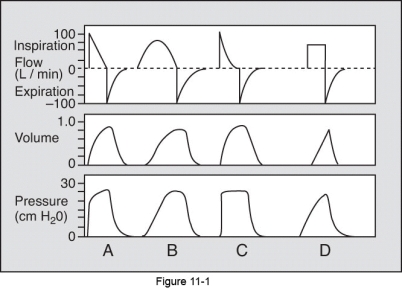
A) A
B) B
C) C
D) D

A) A
B) B
C) C
D) D

Unlock Deck
Unlock for access to all 107 flashcards in this deck.
Unlock Deck
k this deck
25
The maximum safety pressure should be set at _____ cm H₂O when the peak pressure reached during volume-controlled ventilation is 25 cm H₂O.
A) 30
B) 35
C) 40
D) 45
A) 30
B) 35
C) 40
D) 45

Unlock Deck
Unlock for access to all 107 flashcards in this deck.
Unlock Deck
k this deck
26
Which of the following variables cannot be exceeded during inspiration?
A) Limit
B) Cycle
C) Safety
D) Trigger
A) Limit
B) Cycle
C) Safety
D) Trigger

Unlock Deck
Unlock for access to all 107 flashcards in this deck.
Unlock Deck
k this deck
27
Which two of the following patient triggers are most common?
1)Flow
2)Neural
3)Volume
4)Pressure
A) 1 and 2
B) 1 and 4
C) 2 and 3
D) 3 and 4
1)Flow
2)Neural
3)Volume
4)Pressure
A) 1 and 2
B) 1 and 4
C) 2 and 3
D) 3 and 4

Unlock Deck
Unlock for access to all 107 flashcards in this deck.
Unlock Deck
k this deck
28
The figure shows the pressure-time scalar for a pressure-support breath.To alleviate the problem depicted in this figure,the respiratory therapist should do which of the following?
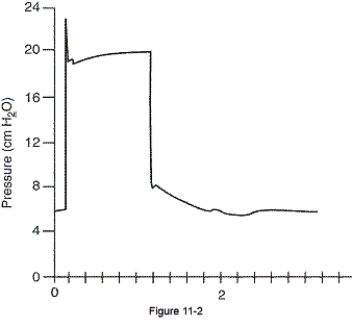
A) Decrease the pressure setting
B) Increase the inspiratory time
C) Add inspiratory sloping
D) Decrease the set volume

A) Decrease the pressure setting
B) Increase the inspiratory time
C) Add inspiratory sloping
D) Decrease the set volume

Unlock Deck
Unlock for access to all 107 flashcards in this deck.
Unlock Deck
k this deck
29
When the maximum safety pressure setting on an adult ventilator is reached,which of the following occurs?
A) Inspiration is triggered.
B) Flow begins to decrease.
C) Inspiration ends prematurely.
D) Pressure is held until the target volume is delivered.
A) Inspiration is triggered.
B) Flow begins to decrease.
C) Inspiration ends prematurely.
D) Pressure is held until the target volume is delivered.

Unlock Deck
Unlock for access to all 107 flashcards in this deck.
Unlock Deck
k this deck
30
What is the flow rate if the set volume is 550 mL and the inspiratory time is 1.2 second?
A) 27.5 L/min
B) 45.8 L/min
C) 55 L/min
D) 66 L/min
A) 27.5 L/min
B) 45.8 L/min
C) 55 L/min
D) 66 L/min

Unlock Deck
Unlock for access to all 107 flashcards in this deck.
Unlock Deck
k this deck
31
Decreased lung compliance during pressure-limited ventilation would cause which of the following?
A) Increased flow rates
B) Increased pressure delivery
C) Decreased volume delivery
D) Decreased inspiratory pressures
A) Increased flow rates
B) Increased pressure delivery
C) Decreased volume delivery
D) Decreased inspiratory pressures

Unlock Deck
Unlock for access to all 107 flashcards in this deck.
Unlock Deck
k this deck
32
Improving lung compliance during volume-controlled ventilation would cause a(n)_____ in peak _____.
A) decease; pressure
B) increase; pressure
C) decrease; flow rate
D) increase; flow rate
A) decease; pressure
B) increase; pressure
C) decrease; flow rate
D) increase; flow rate

Unlock Deck
Unlock for access to all 107 flashcards in this deck.
Unlock Deck
k this deck
33
If the base flow is 8 L/min and the flow-trigger setting is 3 L/min,at what flow rate would the ventilator be triggered?
A) 3 L/min
B) 5 L/min
C) 8 L/min
D) 11 L/min
A) 3 L/min
B) 5 L/min
C) 8 L/min
D) 11 L/min

Unlock Deck
Unlock for access to all 107 flashcards in this deck.
Unlock Deck
k this deck
34
The flow,volume,and pressure waveforms characteristic of volume breaths with a sine-like flow pattern are shown in which column of the figure?
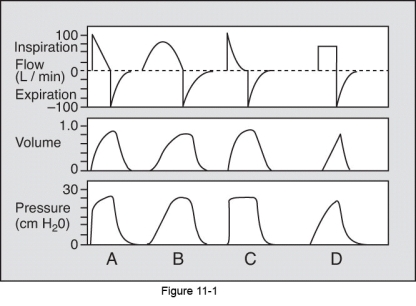
A) A
B) B
C) C
D) D

A) A
B) B
C) C
D) D

Unlock Deck
Unlock for access to all 107 flashcards in this deck.
Unlock Deck
k this deck
35
With a baseline pressure setting of 6 cm H₂O and a sensitivity setting of -1.5 cm H₂O,inspiration will begin at _____ cm H₂O.
A) -1.5
B) -4.5
C) +1.5
D) +4.5
A) -1.5
B) -4.5
C) +1.5
D) +4.5

Unlock Deck
Unlock for access to all 107 flashcards in this deck.
Unlock Deck
k this deck
36
The pressure maintained at the airway during exhalation is known as which of the following?
A) Baseline
B) Proximal
C) Sensitivity
D) Mean airway
A) Baseline
B) Proximal
C) Sensitivity
D) Mean airway

Unlock Deck
Unlock for access to all 107 flashcards in this deck.
Unlock Deck
k this deck
37
If the base flow is 10 L/min and the flow-trigger setting is 4 L/min,the flow during the expiratory phase is _____ L/min.
A) 4
B) 6
C) 10
D) 14
A) 4
B) 6
C) 10
D) 14

Unlock Deck
Unlock for access to all 107 flashcards in this deck.
Unlock Deck
k this deck
38
The flow,volume,and pressure waveforms characteristic of volume breaths with a constant flow are shown in which column of the figure?
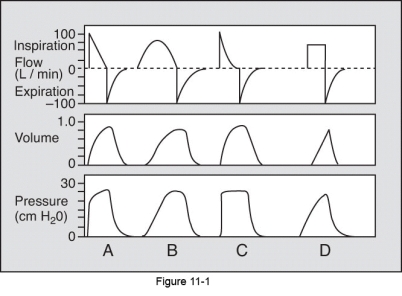
A) A
B) B
C) C
D) D

A) A
B) B
C) C
D) D

Unlock Deck
Unlock for access to all 107 flashcards in this deck.
Unlock Deck
k this deck
39
The flow,volume,and pressure waveforms characteristic of volume breaths with a descending ramp flow pattern are shown in which column of the figure?
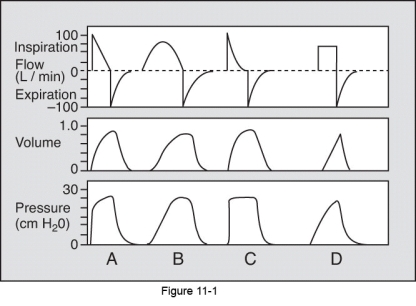
A) A
B) B
C) C
D) D

A) A
B) B
C) C
D) D

Unlock Deck
Unlock for access to all 107 flashcards in this deck.
Unlock Deck
k this deck
40
When the maximum safety pressure on a volume ventilator is reached,which of the following occurs?
A) The flow rate begins to taper.
B) Pressure is held until the time cycle is reached.
C) Pressure is held until the ventilator volume cycles.
D) Inspiration ends before the entire volume is delivered.
A) The flow rate begins to taper.
B) Pressure is held until the time cycle is reached.
C) Pressure is held until the ventilator volume cycles.
D) Inspiration ends before the entire volume is delivered.

Unlock Deck
Unlock for access to all 107 flashcards in this deck.
Unlock Deck
k this deck
41
What is the transairway pressure from the information found in the figure?

A) 10 cm H₂O
B) 15 cm H₂O
C) 25 cm H₂O
D) 35 cm H₂O

A) 10 cm H₂O
B) 15 cm H₂O
C) 25 cm H₂O
D) 35 cm H₂O

Unlock Deck
Unlock for access to all 107 flashcards in this deck.
Unlock Deck
k this deck
42
What is the static lung compliance when the returned tidal volume is 460 mL,the positive end-expiratory pressure is 8 cm H₂O,the peak inspiratory pressure is 27 cm H₂O,and the plateau pressure is 18 cm H₂O?
A) 20 mL/cm H₂O
B) 26 mL/cm H₂O
C) 46 mL/cm H₂O
D) 51 mL/cm H₂O
A) 20 mL/cm H₂O
B) 26 mL/cm H₂O
C) 46 mL/cm H₂O
D) 51 mL/cm H₂O

Unlock Deck
Unlock for access to all 107 flashcards in this deck.
Unlock Deck
k this deck
43
What is the compressibility factor for the patient circuit when the ventilator volume is set at 100 mL,the recorded peak inspiratory pressure is 41 cm H₂O,and the measured volume is 68 mL?
A) 0.41 cm H₂O/mL
B) 0.60 cm H₂O/mL
C) 1.66 mL/cm H₂O
D) 2.44 mL/cm H₂O
A) 0.41 cm H₂O/mL
B) 0.60 cm H₂O/mL
C) 1.66 mL/cm H₂O
D) 2.44 mL/cm H₂O

Unlock Deck
Unlock for access to all 107 flashcards in this deck.
Unlock Deck
k this deck
44
What is the static lung compliance when the returned tidal volume is 700 mL,the positive end-expiratory pressure is 10 cm H₂O,the peak inspiratory pressure is 45 cm H₂O,and the plateau pressure is 35 cm H₂O?
A) 0.160 L/cm H₂O
B) 0.020 L/cm H₂O
C) 0.028 L/cm H₂O
D) 0.735 L/cm H₂O
A) 0.160 L/cm H₂O
B) 0.020 L/cm H₂O
C) 0.028 L/cm H₂O
D) 0.735 L/cm H₂O

Unlock Deck
Unlock for access to all 107 flashcards in this deck.
Unlock Deck
k this deck
45
Worsening lung compliance during volume-controlled ventilation would cause which of the following?
A) A decrease in peak pressure
B) An increase in peak pressure
C) A decrease in volume delivery
D) An increase in peak flow rate
A) A decrease in peak pressure
B) An increase in peak pressure
C) A decrease in volume delivery
D) An increase in peak flow rate

Unlock Deck
Unlock for access to all 107 flashcards in this deck.
Unlock Deck
k this deck
46
What is the compressibility factor for the patient circuit when the ventilator volume is set at 200 mL,the recorded peak inspiratory pressure is 72 cm H₂O,and the measured volume is 148 mL?
A) 0.36 cm H₂O/mL
B) 0.49 cm H₂O/mL
C) 2.06 mL/cm H₂O
D) 2.78 mL/cm H₂O
A) 0.36 cm H₂O/mL
B) 0.49 cm H₂O/mL
C) 2.06 mL/cm H₂O
D) 2.78 mL/cm H₂O

Unlock Deck
Unlock for access to all 107 flashcards in this deck.
Unlock Deck
k this deck
47
Pressure-support ventilation is classified as:
1)Flow cycled
2)Time triggered
3)Volume targeted
4)Pressure targeted
5)Patient triggered
A) 2 and 3
B) 4 and 5
C) 1,4,and 5
D) 1,2,and 3
1)Flow cycled
2)Time triggered
3)Volume targeted
4)Pressure targeted
5)Patient triggered
A) 2 and 3
B) 4 and 5
C) 1,4,and 5
D) 1,2,and 3

Unlock Deck
Unlock for access to all 107 flashcards in this deck.
Unlock Deck
k this deck
48
Worsening lung compliance during pressure-controlled ventilation would cause which of the following?
A) A decrease in peak pressure
B) An increase in peak pressure
C) A decrease in volume delivery
D) An increase in peak flow rate
A) A decrease in peak pressure
B) An increase in peak pressure
C) A decrease in volume delivery
D) An increase in peak flow rate

Unlock Deck
Unlock for access to all 107 flashcards in this deck.
Unlock Deck
k this deck
49
What is the volume that will reach the patient when the volume setting is 700 mL,the tubing compliance is 2 mL/cm H₂O,and the measured peak inspiratory pressure is 35 cm H₂O?
A) 770 mL
B) 698 mL
C) 665 mL
D) 630 mL
A) 770 mL
B) 698 mL
C) 665 mL
D) 630 mL

Unlock Deck
Unlock for access to all 107 flashcards in this deck.
Unlock Deck
k this deck
50
During volume ventilation,peak inspiratory pressure is the pressure needed to overcome which two of the following factors?
1)Muscle pressure
2)Airflow resistance
3)Elastic recoil pressure
4)Transthoracic pressure
A) 1 and 2
B) 1 and 3
C) 3 and 4
D) 2 and 3
1)Muscle pressure
2)Airflow resistance
3)Elastic recoil pressure
4)Transthoracic pressure
A) 1 and 2
B) 1 and 3
C) 3 and 4
D) 2 and 3

Unlock Deck
Unlock for access to all 107 flashcards in this deck.
Unlock Deck
k this deck
51
Increasing the functional residual capacity of a spontaneously breathing patient to improve oxygenation can be accomplished by which of the following?
A) Inspiratory plateau
B) Positive end-expiratory pressure
C) Negative end-expiratory pressure
D) Continuous positive airway pressure
A) Inspiratory plateau
B) Positive end-expiratory pressure
C) Negative end-expiratory pressure
D) Continuous positive airway pressure

Unlock Deck
Unlock for access to all 107 flashcards in this deck.
Unlock Deck
k this deck
52
Plateau pressure may be obtained during volume ventilation by using which of the following?
A) Expiratory pause
B) Inspiratory pause
C) End-expiratory pressure
D) Increased inspiratory time
A) Expiratory pause
B) Inspiratory pause
C) End-expiratory pressure
D) Increased inspiratory time

Unlock Deck
Unlock for access to all 107 flashcards in this deck.
Unlock Deck
k this deck
53
During pressure-targeted ventilation with a set pressure of 24 cm H₂O,the patient coughs.The ventilator responds by in which of the following ways?
A) Inspiration ends immediately.
B) Inspiratory time increases.
C) Inspiration continues with the set pressure.
D) Inspiratory pressure ends at the maximum safety pressure.
A) Inspiration ends immediately.
B) Inspiratory time increases.
C) Inspiration continues with the set pressure.
D) Inspiratory pressure ends at the maximum safety pressure.

Unlock Deck
Unlock for access to all 107 flashcards in this deck.
Unlock Deck
k this deck
54
What is the static lung compliance when the returned tidal volume is 500 mL,the baseline pressure is zero,and the plateau pressure reading is 25 cm H₂O?
A) 0.02 L/cm H₂O
B) 2.0 L/cm H₂O
C) 0.2 L/cm H₂O
D) 2.0 L/cm H₂O
A) 0.02 L/cm H₂O
B) 2.0 L/cm H₂O
C) 0.2 L/cm H₂O
D) 2.0 L/cm H₂O

Unlock Deck
Unlock for access to all 107 flashcards in this deck.
Unlock Deck
k this deck
55
Increased transairway pressure is associated with which two of the following changes?
1)Increased airway resistance
2)Decreased airway resistance
3)Increased static compliance
4)Decreased static compliance
A) 3 and 4
B) 1 and 3
C) 2 and 4
D) 1 and 2
1)Increased airway resistance
2)Decreased airway resistance
3)Increased static compliance
4)Decreased static compliance
A) 3 and 4
B) 1 and 3
C) 2 and 4
D) 1 and 2

Unlock Deck
Unlock for access to all 107 flashcards in this deck.
Unlock Deck
k this deck
56
Which of the following is the formula for transairway pressure?
A) Peak inspiratory pressure - Plateau pressure
B) Plateau pressure - Peak inspiratory pressure
C) Positive end-expiratory pressure - Plateau pressure
D) Peak inspiratory pressure - Positive end-expiratory pressure
A) Peak inspiratory pressure - Plateau pressure
B) Plateau pressure - Peak inspiratory pressure
C) Positive end-expiratory pressure - Plateau pressure
D) Peak inspiratory pressure - Positive end-expiratory pressure

Unlock Deck
Unlock for access to all 107 flashcards in this deck.
Unlock Deck
k this deck
57
Which of the following flow-termination settings for a pressure-supported breath that has a peak inspiratory flow of 30 L/min would allow enough time for a visible plateau on the pressure-time curve?
A) 5 L/min
B) 20 L/min
C) 20% of peak flow
D) 30% of peak flow
A) 5 L/min
B) 20 L/min
C) 20% of peak flow
D) 30% of peak flow

Unlock Deck
Unlock for access to all 107 flashcards in this deck.
Unlock Deck
k this deck
58
Improving lung compliance during pressure-controlled ventilation would cause which of the following?
A) A decrease in peak pressure
B) An increase in peak pressure
C) An increase in volume delivery
D) A decrease in volume delivery
A) A decrease in peak pressure
B) An increase in peak pressure
C) An increase in volume delivery
D) A decrease in volume delivery

Unlock Deck
Unlock for access to all 107 flashcards in this deck.
Unlock Deck
k this deck
59
The transairway pressure represents the pressure associated with which of the following?
A) Elastic recoil
B) Airflow resistance
C) Tubing compressibility
D) End-expiratory pressure
A) Elastic recoil
B) Airflow resistance
C) Tubing compressibility
D) End-expiratory pressure

Unlock Deck
Unlock for access to all 107 flashcards in this deck.
Unlock Deck
k this deck
60
How much volume is lost in the ventilator circuit when the volume is set at 500 mL,the peak inspiratory pressure is 40 cm H₂O,and the tubing compliance is 3 mL/cm H₂O?
A) 380 mL
B) 280 mL
C) 150 mL
D) 120 mL
A) 380 mL
B) 280 mL
C) 150 mL
D) 120 mL

Unlock Deck
Unlock for access to all 107 flashcards in this deck.
Unlock Deck
k this deck
61
What procedure is used to estimate the amount of air trapped in the patient's lungs and in the patient circuit?
A) Inspiratory pause
B) End-expiratory pause
C) Pressure-control ventilation
D) Pressure-release ventilation
A) Inspiratory pause
B) End-expiratory pause
C) Pressure-control ventilation
D) Pressure-release ventilation

Unlock Deck
Unlock for access to all 107 flashcards in this deck.
Unlock Deck
k this deck
62
Mandatory breaths during pressure-controlled mechanical ventilation (pressure-controlled continuous mandatory ventilation)are cycled into expiration by which of the following?
A) Time
B) Flow
C) Volume
D) Pressure
A) Time
B) Flow
C) Volume
D) Pressure

Unlock Deck
Unlock for access to all 107 flashcards in this deck.
Unlock Deck
k this deck
63
The pressure support level is automatically adjusted by the ventilator to maintain appropriate breathing frequency,tidal volume,and end-tidal carbon dioxide,depending on the patient's pathologic condition.This mode description pertains to which of the following ventilator control types?
A) Adaptive
B) Set-point
C) Knowledge-based
D) Neurally adjusted ventilatory assist
A) Adaptive
B) Set-point
C) Knowledge-based
D) Neurally adjusted ventilatory assist

Unlock Deck
Unlock for access to all 107 flashcards in this deck.
Unlock Deck
k this deck
64
The description "a mode where each breath is pressure limited and the pressure-limit level is adjusted automatically between breaths by using ventilatory mechanics to minimize the patient's work of breathing" pertains to which ventilator control type?
A) Servo
B) Optimal
C) Adaptive
D) Auto-set-point
A) Servo
B) Optimal
C) Adaptive
D) Auto-set-point

Unlock Deck
Unlock for access to all 107 flashcards in this deck.
Unlock Deck
k this deck
65
Auto-PEEP can be detected without the use of an expiratory pause on which of the following curves?
A) Pressure-time
B) Flow-time
C) Pressure-volume
D) Volume-time
A) Pressure-time
B) Flow-time
C) Pressure-volume
D) Volume-time

Unlock Deck
Unlock for access to all 107 flashcards in this deck.
Unlock Deck
k this deck
66
Which of the following represents the safe starting point for pressure support of a patient just placed on volume-controlled intermittent mandatory ventilation with the following set and measured parameters: tidal volume,475 mL; peak inspiratory pressure,30 cm H₂O; plateau pressure,10 cm H₂O; and flow rate,45 L/min?
A) 4 cm H₂O
B) 7 cm H₂O
C) 20 cm H₂O
D) 27 cm H₂O
A) 4 cm H₂O
B) 7 cm H₂O
C) 20 cm H₂O
D) 27 cm H₂O

Unlock Deck
Unlock for access to all 107 flashcards in this deck.
Unlock Deck
k this deck
67
Which of the following is the technique that can actively remove gas from a ventilator circuit at the beginning of expiration?
A) Expiratory pause
B) Inspiratory pause
C) Positive end-expiratory pressure
D) Negative end-expiratory pressure
A) Expiratory pause
B) Inspiratory pause
C) Positive end-expiratory pressure
D) Negative end-expiratory pressure

Unlock Deck
Unlock for access to all 107 flashcards in this deck.
Unlock Deck
k this deck
68
Which of the following control modes of ventilation consists of ventilator output automatically following a varying input (e.g.,volume or flow generated by the patient)?
A) Servo
B) Optimal
C) Neural network
D) Knowledge-based
A) Servo
B) Optimal
C) Neural network
D) Knowledge-based

Unlock Deck
Unlock for access to all 107 flashcards in this deck.
Unlock Deck
k this deck
69
Which of the following ventilator modes decreases the effect of airway resistance on the patient's spontaneous breathing?
A) Pressure-support ventilation
B) Pressure-controlled continuous mandatory ventilation
C) Volume-controlled intermittent mandatory ventilation
D) Volume-controlled continuous mandatory ventilation
A) Pressure-support ventilation
B) Pressure-controlled continuous mandatory ventilation
C) Volume-controlled intermittent mandatory ventilation
D) Volume-controlled continuous mandatory ventilation

Unlock Deck
Unlock for access to all 107 flashcards in this deck.
Unlock Deck
k this deck
70
Adult candidates for pressure-support ventilation include patients with which of the following?
1)Nasotracheal tube
2)Minute ventilation <10 L
3)Spontaneous tidal volume <100 mL
4)Spontaneous respiratory rate >20 breaths/min
A) 1 and 2
B) 1 and 4
C) 2,3,and 4
D) 1,3,and 4
1)Nasotracheal tube
2)Minute ventilation <10 L
3)Spontaneous tidal volume <100 mL
4)Spontaneous respiratory rate >20 breaths/min
A) 1 and 2
B) 1 and 4
C) 2,3,and 4
D) 1,3,and 4

Unlock Deck
Unlock for access to all 107 flashcards in this deck.
Unlock Deck
k this deck
71
Which of the following is a mode of ventilation that is time triggered or patient triggered as well as pressure limited and time cycled?
A) Pressure-support ventilation
B) Pressure-controlled intermittent mandatory ventilation
C) Pressure-controlled continuous mandatory ventilation
D) Dual control continuous mandatory ventilation
A) Pressure-support ventilation
B) Pressure-controlled intermittent mandatory ventilation
C) Pressure-controlled continuous mandatory ventilation
D) Dual control continuous mandatory ventilation

Unlock Deck
Unlock for access to all 107 flashcards in this deck.
Unlock Deck
k this deck
72
Which of the following ventilator modes is recommended for patients who have intact respiratory centers and who are breathing spontaneously?
A) Intermittent mandatory ventilation
B) Pressure-support ventilation
C) Pressure-controlled ventilation
D) Continuous mandatory ventilation
A) Intermittent mandatory ventilation
B) Pressure-support ventilation
C) Pressure-controlled ventilation
D) Continuous mandatory ventilation

Unlock Deck
Unlock for access to all 107 flashcards in this deck.
Unlock Deck
k this deck
73
The mandatory breath begins as a pressure-controlled breath,but it switches to volume control during inspiration because a preset volume is not achieved. This describes which of the following control types?
A) Set-point
B) Adaptive
C) Auto-set-point
D) Knowledge-based
A) Set-point
B) Adaptive
C) Auto-set-point
D) Knowledge-based

Unlock Deck
Unlock for access to all 107 flashcards in this deck.
Unlock Deck
k this deck
74
The ventilator mode that is either patient triggered or time triggered and allows the patient to breathe spontaneously between mandatory ventilator breaths is known as:
A) Pressure-support ventilation
B) Pressure-controlled ventilation
C) Intermittent mandatory ventilation
D) Continuous mandatory ventilation
A) Pressure-support ventilation
B) Pressure-controlled ventilation
C) Intermittent mandatory ventilation
D) Continuous mandatory ventilation

Unlock Deck
Unlock for access to all 107 flashcards in this deck.
Unlock Deck
k this deck
75
What does point A represent on the pressure-time scalar shown in the figure?
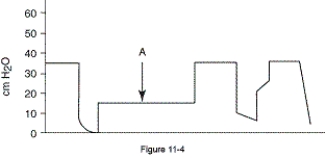
A) Plateau pressure
B) Maximum safety pressure
C) Positive end-expiratory pressure
D) Auto-PEEP

A) Plateau pressure
B) Maximum safety pressure
C) Positive end-expiratory pressure
D) Auto-PEEP

Unlock Deck
Unlock for access to all 107 flashcards in this deck.
Unlock Deck
k this deck
76
Which of the following control modes of ventilation consists of pressure-limited mandatory breaths that can be automatically adjusted between breaths to achieve a preset tidal volume?
A) Servo
B) Optimal
C) Adaptive
D) Auto-set-point
A) Servo
B) Optimal
C) Adaptive
D) Auto-set-point

Unlock Deck
Unlock for access to all 107 flashcards in this deck.
Unlock Deck
k this deck
77
Which of the following ventilator control types consists of the output of the ventilator automatically matching a constant operator-preset input value?
A) Optimal
B) Set-point
C) Auto-set-point
D) Knowledge-based
A) Optimal
B) Set-point
C) Auto-set-point
D) Knowledge-based

Unlock Deck
Unlock for access to all 107 flashcards in this deck.
Unlock Deck
k this deck
78
Which of the following is a ventilator mode that allows the ventilator to switch from pressure control to volume control or vice versa?
A) Dual-control mode
B) Flow-control mode
C) Volume-control mode
D) Pressure-control mode
A) Dual-control mode
B) Flow-control mode
C) Volume-control mode
D) Pressure-control mode

Unlock Deck
Unlock for access to all 107 flashcards in this deck.
Unlock Deck
k this deck
79
Which of the following statements is true concerning mechanical ventilation classification?
A) The names for modes of ventilation are current and accurate.
B) Mode classification should be individualized by manufacturers.
C) Mode classification terminology needs to be clearly defined.
D) All manufacturer mode terminology adheres to Chatburn's system.
A) The names for modes of ventilation are current and accurate.
B) Mode classification should be individualized by manufacturers.
C) Mode classification terminology needs to be clearly defined.
D) All manufacturer mode terminology adheres to Chatburn's system.

Unlock Deck
Unlock for access to all 107 flashcards in this deck.
Unlock Deck
k this deck
80
A dual mode that features a pressure-controlled breath pattern with volume as a conditional variable is which of the following?
A) Tactical control ventilation
B) Pressure-targeted ventilation
C) Pressure-regulated volume control
D) Volume-regulated pressure control
A) Tactical control ventilation
B) Pressure-targeted ventilation
C) Pressure-regulated volume control
D) Volume-regulated pressure control

Unlock Deck
Unlock for access to all 107 flashcards in this deck.
Unlock Deck
k this deck



